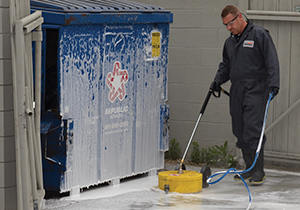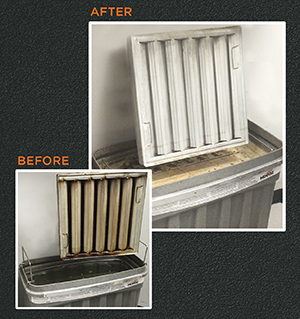4 tips for cleaning your commercial kitchen equipment the right way.
By Breann Marvin-Loffing, CFE
The Center for Disease Control (CDC) estimates about 48 million people in the U.S. get sick each year from foodborne illnesses. Half of the reported cases were traced back to a restaurant or deli, likely because strict sanitation procedures were not followed. Many commercial kitchens handle a variety of food products each day, which can turn them into a breeding ground for germs and bacteria.
There are more than 250 known pathogens that can contaminate food and beverages. To reduce the likelihood of a bacteria outbreak, implementing strict kitchen equipment cleaning procedures is an obvious first step. Follow these four pro tips to guarantee your facility is a safe and clean environment for patrons:
- Disassemble conveyor ovens and stoves for cleanings. As one of the most frequently used items in a commercial kitchen, it is easy for grease and grime to build up on ovens and stoves. The first step in keeping this equipment as clean as possible is to train kitchen staff to always remove loose debris and wipe up spills as they occur. For tougher grease stains and hard-to-remove debris, kitchen staff should utilize a brush or scraper to effectively clean the surface. In addition to strict staff protocols, restaurant managers are encouraged to hire a professional cleaning service to administer a deep clean of the conveyor oven on a regular basis. There are various components that make up the machinery including belts, racks and bake chambers that require a professional to disassemble in order to obtain a thorough clean. Not only will hiring a professional ensure your conveyor oven and stove are sanitary, but removing excess grease buildup will result in higher quality food products, decreased risk of fire, increased equipment life, and increased energy efficiency.
 Spray down the dumpster pad. A restaurant’s dumpster pad should be located at least 50 feet away from the facility. It is incredibly important to clean the dumpster pad regularly as kitchen staff will frequent this area. Restaurant employees should use a hose to spray down the area at least once a week to remove excess debris and grease as well as reduce the spread of harmful bacteria. To prevent transferring germs from this bacteria-ridden area into the kitchen, staff should also always wash their hands with soap and water immediately after going to the dumpster. In addition, a dumpster deodorizer can be used to help treat smells resulting from rotting waste. These odors are not only unpleasant, but can also attract pesky rodents and vermin that carry bacteria. Keeping the dumpster pad area clean can be a daunting and sordid task, but ensuring its sanitation is critical to the cleanliness of the kitchen.
Spray down the dumpster pad. A restaurant’s dumpster pad should be located at least 50 feet away from the facility. It is incredibly important to clean the dumpster pad regularly as kitchen staff will frequent this area. Restaurant employees should use a hose to spray down the area at least once a week to remove excess debris and grease as well as reduce the spread of harmful bacteria. To prevent transferring germs from this bacteria-ridden area into the kitchen, staff should also always wash their hands with soap and water immediately after going to the dumpster. In addition, a dumpster deodorizer can be used to help treat smells resulting from rotting waste. These odors are not only unpleasant, but can also attract pesky rodents and vermin that carry bacteria. Keeping the dumpster pad area clean can be a daunting and sordid task, but ensuring its sanitation is critical to the cleanliness of the kitchen.
- Invest in regular professional exhaust hood cleanings. Commercial kitchen exhaust hood systems are in place to collect airborne grease. However, if not properly cleaned and maintained, this grease can drip from the hood system, contaminating food that is being prepared, and can even lead to dangerous fires. To prevent the spread of pathogenic bacteria from grease, it is important for employees to clean the external kitchen hood as part of their regular cleaning and maintenance routines. A thoroughly cleaned kitchen exhaust system also means cleaning beyond what is immediately visible, which is a more complex process. Enlisting a professional to properly clean the entire system will both guarantee a fully sanitized kitchen, and ensure your restaurant is compliant with National Fire Protection Association standards.
- Properly sanitize all cooking equipment. Restaurants often handle different types of food products like raw meat, fresh fruits and vegetables at the same time, so it is vital that all work surfaces and equipment be properly cleaned between uses to prevent cross contamination. To start with, kitchen staff should be taught to wash and sanitize tools such as cutting boards, slicers and cooking utensils in between each use to prevent the transmission of harmful pathogens. For cookware like broiler grates, baking sheets and fryer baskets, which can become caked in hard-to-clean grease, many restaurant managers choose to invest in a soak tank service program. The soak tank is designed to clean this equipment overnight using a non-corrosive, non-toxic, biodegradable cleaning solution. By investing in this type of service, restaurant managers can rest easy knowing even the toughest grease stains will be removed.
 Given how easy it is for foodborne bacteria to spread in the kitchen, maintaining a sanitary operation should be a facility’s top priority. Implementing strict staff guidelines for personal hygiene combined with mandated equipment cleaning policies will help ensure that a commercial kitchen is the cleanest possible cooking environment. With these professional grade tips in mind, restaurant managers can work to ensure their kitchen gets the deep clean it needs to be safe and sanitary for both guests and employees.
Given how easy it is for foodborne bacteria to spread in the kitchen, maintaining a sanitary operation should be a facility’s top priority. Implementing strict staff guidelines for personal hygiene combined with mandated equipment cleaning policies will help ensure that a commercial kitchen is the cleanest possible cooking environment. With these professional grade tips in mind, restaurant managers can work to ensure their kitchen gets the deep clean it needs to be safe and sanitary for both guests and employees.
— Breann Marvin-Loffing, CFE is the vice president of franchise operations at HOODZ International, a recognized leader in the commercial kitchen exhaust system cleaning and preventive maintenance industry. For more information, visit www.hoodzinternational.com.
